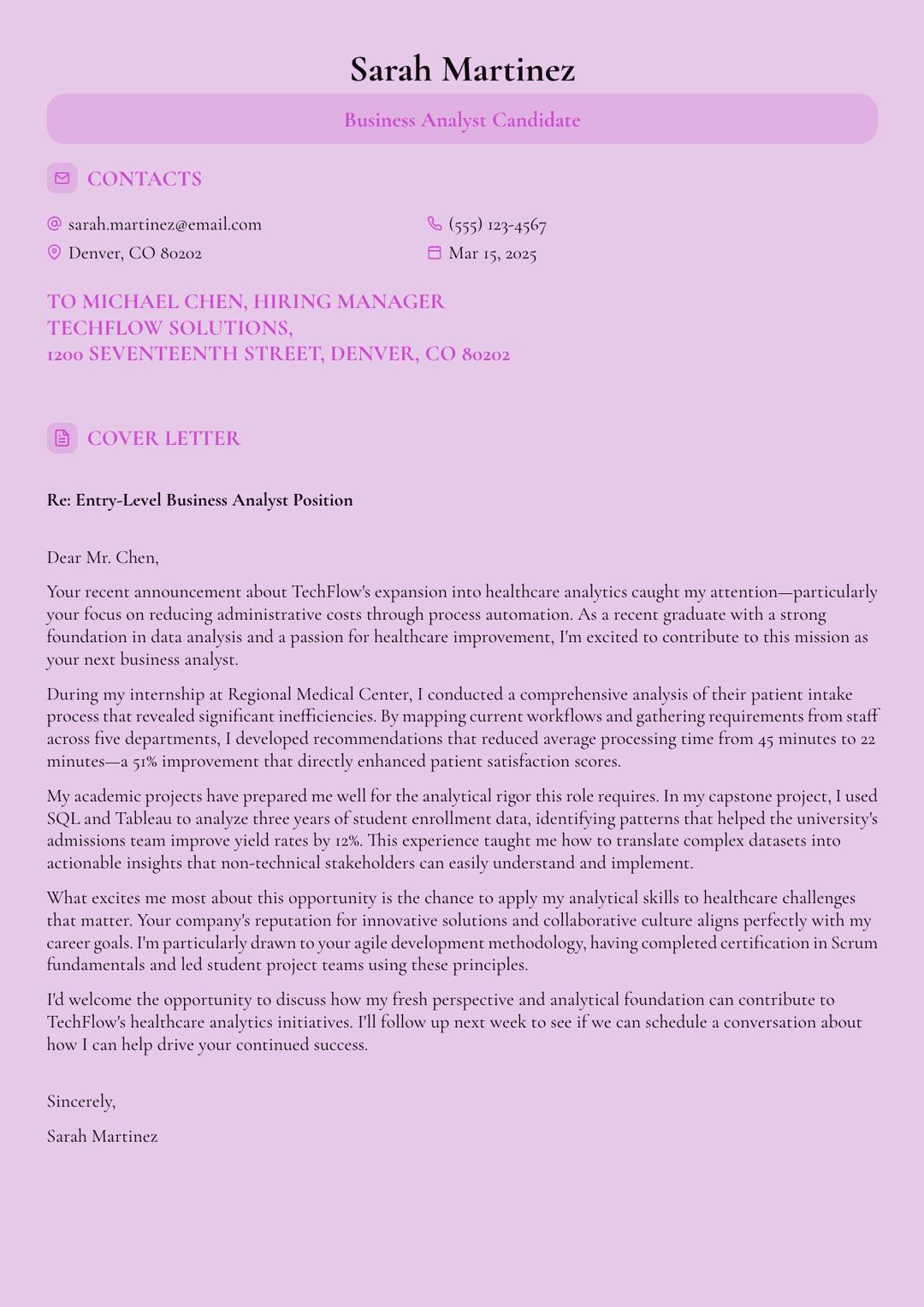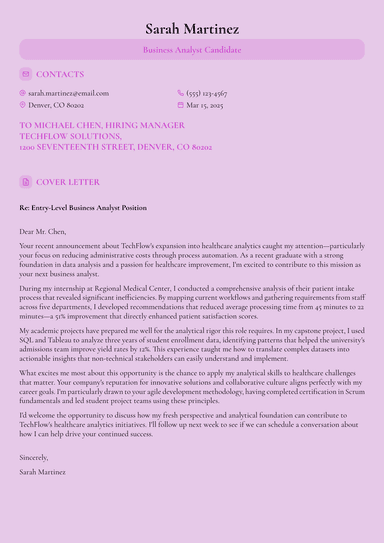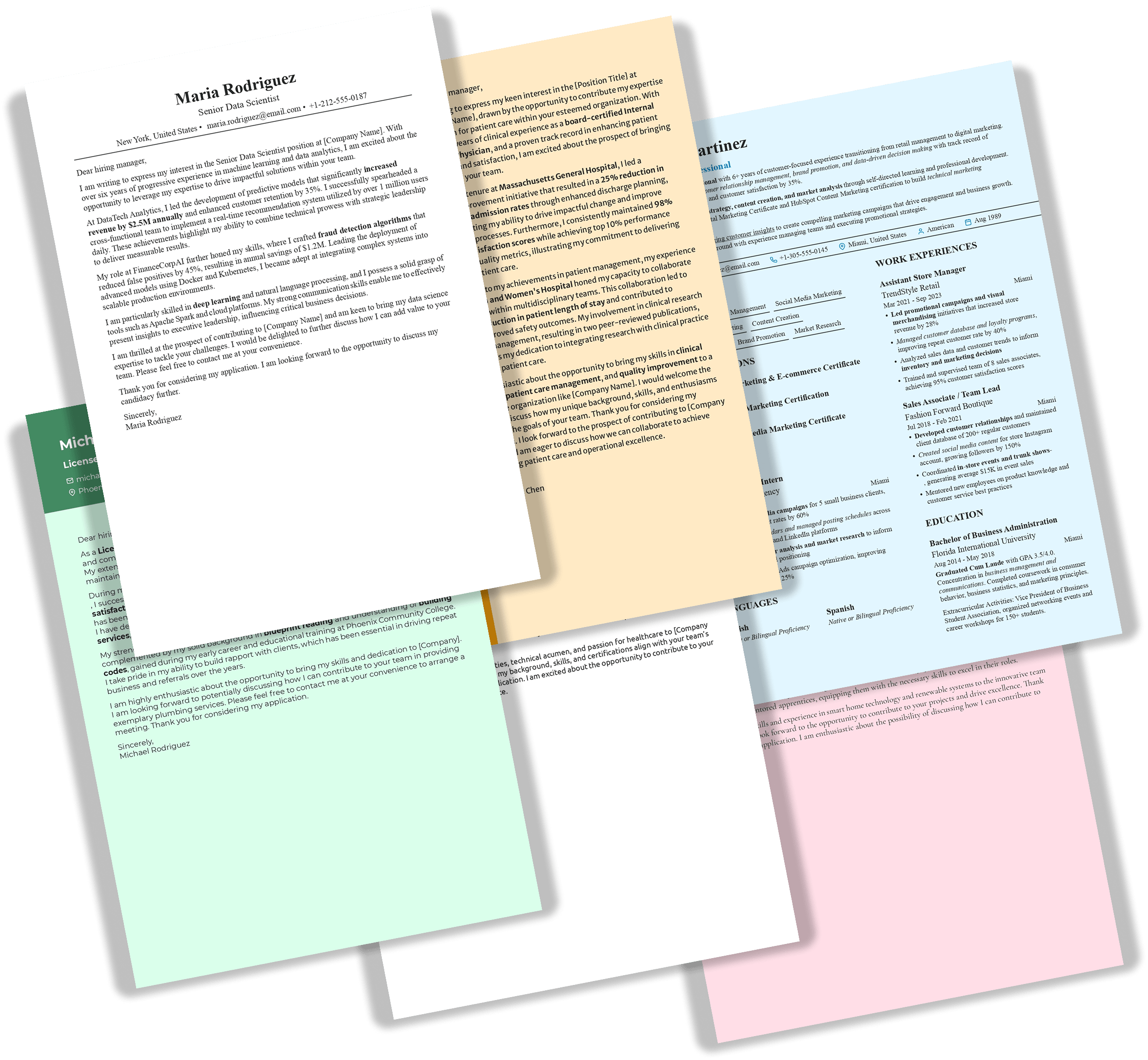How to Write a Business Analyst Cover Letter in 2025 (w/ Examples & Templates)
This complete guide with expert tips and real examples will teach you how to write a compelling cover letter — fast and stress-free!
Edit this cover letter
Knowing how to write a business analyst cover letter can make the difference between landing an interview and having your application overlooked by hiring managers. Whether you're an entry-level candidate breaking into the field or an experienced professional seeking career advancement, the challenge remains the same: how to translate complex analytical work into compelling narratives that resonate with recruiters?
That's where this guide comes in. We'll show you how to write a business analyst cover letter and walk you through some examples. Furthermore, we’ll offer you customizable templates and expert strategies to help you get to the interviewing stage.
- Customize your business analyst cover letter to the job description, challenges, and industry.
- Balance technical expertise with business understanding to show you bridge both worlds.
- Quantify achievements to prove real business impact and connect tools (SQL, Tableau, Python, Agile) directly to measurable outcomes.
- Highlight essential business analyst skills: requirements gathering, process improvement, data analysis, stakeholder management, and change management.
- Avoid generic templates, irrelevant details, and formatting errors. Furthermore, keep it professional, polished, and consistent with your resume.
What Makes a Strong Business Analyst Cover Letter?
To make a strong business analyst cover letter, you need to showcase your ability to bridge the gap between business needs and technical solutions—a skill that sets apart mediocre analysts from exceptional ones.
According to the Bureau of Labor Statistics, employment of management analysts (which includes business analysts) is projected to grow 10% by 2032, faster than the average for all occupations. Furthermore, in case you were wondering whether a cover letter is necessary, according to recent studies 89% of recruiters expect candidates to submit a cover letter. This makes a compelling cover letter even more critical for standing out.
To succeed, you need to tell a story about how you've translated complex data into actionable insights that drive business decisions. This means highlighting skills like requirements gathering, process improvement, stakeholder communication, and data analysis while connecting each capability to real business outcomes.
Think of your cover letter as a mini case study. You're not just listing what you can do; you're proving how your analytical approach has solved problems similar to what this company faces. This requires research, strategic thinking, and the ability to connect dots that others might miss.
Job-Winning Business Analyst Cover Letter Examples
Given that good preparation is essential for success, here are a few examples you can use for inspiration for your own cover letter, depending on your career level and experience.
Entry-Level Business Analyst Cover Letter Example
This entry-level cover letter connects academic experience to real business value while showing genuine research into the company's direction. The candidate quantifies achievements even from internships and projects, demonstrating analytical thinking from the start.
Experienced Business Analyst Cover Letter Example
This cover letter works because it demonstrates progression, quantifies major achievements, and shows understanding of the company's specific challenges. Furthermore, the letter balances technical competence with business acumen while maintaining a confident but respectful tone.
Career Change to Business Analyst Cover Letter Example
This career change cover letter acknowledges the transition while emphasizing transferable skills and quantifiable achievements. The candidate shows initiative through additional education and connects retail experience to banking challenges in relevant ways.
How to Write a Business Analyst Cover Letter in 5 Steps
Writing an effective business analyst cover letter requires a systematic approach that mirrors the analytical thinking you'll use in the role. Like in any good analysis project, you should start with research, follow a logical structure, and conclude with clear recommendations—in this case, why you're the right candidate for the job.
Remember that hiring managers often review dozens of applications daily. Your cover letter has approximately 30 seconds to capture their attention and convince them you're worth a closer look.
Let’s examine each step in the writing process, so you can stand out from the crowd.
#1. Research the Company and Role
Before writing a single word, thoroughly research the company, its recent challenges, and growth initiatives. This isn't just about visiting their website—dig deeper into their industry, competitive landscape, and current market position.
Here’s what you should check during your research process:
- Company mission, values, and recent news
- Industry trends and competitive challenges
- Job description keywords and requirements
- Hiring manager's background (LinkedIn research)
- Technology stack and methodologies mentioned
- Company culture and work environment indicators
All of these insights will help you tailor your cover letter to demonstrate how you can solve their specific business problems.
#2. Create a Compelling Opening
Your opening paragraph serves as an elevator pitch. It should immediately demonstrate value while showing you've done your homework. Avoid generic statements, instead, reference something specific about their business that connects to your experience and skills.
I am writing to apply for the business analyst position.
Strong openings often reference recent company news, industry challenges, or strategic initiatives that align with your background. Here’s a good example of how you can write an opening for your business analyst cover letter.
Your recent announcement about expanding into Southeast Asian markets creates exactly the kind of cross-cultural business analysis challenges I've successfully navigated throughout my career.
Another effective approach is leading with a quantified achievement that directly relates to their needs. If they're struggling with cost reduction, open with your most impressive cost-saving project. If they're implementing new technology, highlight your experience with similar transformations.
#3. Highlight Relevant Skills and Experience
The body of your cover letter should focus on achievements that demonstrate your analytical capabilities and business impact.
Here’s how you can do it:
- Use the STAR method (Situation, Task, Action, Result). Structure your examples, but keep them concise and focused on business outcomes. Rather than walking through every detail of a project, highlight the analytical approach you took and the measurable results you achieved.
- Focus on real-life examples. Provide specific examples of process improvements you've implemented, such as "Redesigned the order fulfillment process by conducting stakeholder interviews across five departments and mapping 23 different workflow scenarios, resulting in 40% reduction in processing time and $300K annual savings."
- Include cost savings or revenue increases. Focus on the ones you've contributed to, but be specific about your role in achieving these outcomes. "Contributed to cost savings" is weak; "Identified redundant vendor contracts through spend analysis, negotiating consolidation that eliminated $150K in annual expenses" demonstrates ownership and analytical thinking.
- Showcase successful projects. These should be the ones you've led or participated in, emphasizing the analytical methodologies you used and the business value you delivered. Also, connect each example to skills mentioned in their job description naturally.
- Mention relevant technical skills and certifications. Instead of listing "SQL, Tableau, Agile," explain how these tools helped you deliver results: "Used SQL to extract customer behavior data and Tableau to create executive dashboards that identified upselling opportunities worth $500K annually." This way, you show them in context, which strengthens your chances for success.
#4. Show Your Business Acumen
Demonstrate your understanding of business operations, industry trends, and how analysis drives decision-making. This is what separates business analysts from data analysts—the ability to connect technical analysis to strategic business outcomes.
Use business terminology appropriately throughout your letter, but avoid jargon that might confuse non-technical readers. Furthermore, show how your analytical work has influenced business decisions at previous employers.
Lastly, reference industry challenges or trends that affect their business, and connect these to your experience. This shows you understand the broader context in which they operate and can contribute strategic thinking alongside analytical skills.
#5. Close with a Strong Call to Action
End your cover letter by reiterating your interest and value proposition while requesting specific next steps. Avoid passive language like "I hope to hear from you" in favor of more direct approaches that demonstrate initiative and confidence.
Express genuine enthusiasm for contributing to their team and organization. Specificity matters here too—mention particular aspects of their business, culture, or challenges that genuinely appeal to you. Generic enthusiasm feels hollow; specific interest demonstrates research and genuine fit.
Mention that you'll follow up within a specific timeframe, then actually do it. This shows initiative and persistence—qualities that successful business analysts need when pushing projects forward and managing stakeholder relationships.
Thank them for their time and consideration, but keep this brief and natural. Your closing should feel confident and professional rather than desperate or overly grateful.
Here’s a good example you can use:
I would welcome the opportunity to bring my experience in data-driven decision-making and cross-functional collaboration to XYZ Company. With a proven track record of translating complex data into actionable insights—such as reducing reporting time by 25% in my previous role—I am confident I can add measurable value to your team. Thank you for considering my application, and I look forward to the possibility of discussing how my skills can contribute to XYZ Company's continued success.
Business Analyst Cover Letter Template
Here's a customizable cover letter template you can adapt for your own applications. Remember to personalize every section based on your specific experience and the role requirements:
How to Customize the Template?
The table below shows you have to customize each section of the business analyst cover letter template:
| Section | Customization Tips | Example Elements |
|---|---|---|
Opening Hook | Reference recent company news, industry challenges, or strategic initiatives | "Your Q3 announcement about AI implementation..." |
Achievement 1 | Use the STAR method with quantified results | "Analyzed customer data → identified trends → increased revenue by X%" |
Achievement 2 | Show different skill set, complement first example | Technical skills, leadership, process improvement |
Closing | Specific enthusiasm + clear next steps | "I'll follow up next Tuesday to discuss..." |
Which Skills to Highlight in Your Business Analyst Cover Letter?
When writing a business analyst cover letter, the right skills can make all the difference. Beyond listing tools or buzzwords, your letter should connect skills to business outcomes, showing hiring managers how you solve problems, support decisions, and drive value.
Let’s examine this in more detail.
Technical Skills
Strong technical skills allow business analysts to transform raw data into actionable insights. The table below shows which hard skills you can use for greatest impact.
| Skill Category | Tools & Technologies | Business Application |
|---|---|---|
Data Analysis | Excel, SQL, Python, R | Extract insights, identify trends, support decision-making |
Visualization | Tableau, Power BI, Qlik | Create dashboards, present findings, stakeholder communication |
Project Management | JIRA, Confluence, Asana | Track requirements, manage timelines, collaborate effectively |
Process Modeling | Visio, Lucidchart, Bizagi | Document workflows, identify improvements, design solutions |
Database Management | MySQL, PostgreSQL, Oracle | Query data, validate requirements, ensure data integrity |
Soft Skills
While technical expertise gets attention, soft skills often determine success in a business analyst role. Communication is essential, as you’ll need to bridge gaps between technical teams and stakeholders. Highlight examples of clear facilitation or persuasive presentations that drove business decisions.
Furthermore, problem-solving skills show creativity and logic, while stakeholder management demonstrates your ability to balance competing priorities. You should also emphasize requirements elicitation skills—gathering needs through workshops, interviews, and analysis—and change management, ensuring solutions are actually adopted. By blending interpersonal skills with analytical thinking, you show that you can move insights into action.
Industry-Specific Knowledge
Generic BA skills become more valuable when grounded in industry knowledge. Tailoring your cover letter to show familiarity with your target sector sets you apart.
Here’s how you can do it in different industries:
| Industry | Key Focus Areas | Common Challenges |
|---|---|---|
Healthcare | HIPAA compliance, patient outcomes, cost reduction | Regulatory changes, interoperability, data security |
Financial Services | Risk management, regulatory reporting, customer analytics | Compliance costs, digital transformation, fraud prevention |
Manufacturing | Supply chain optimization, quality control, lean processes | Automation integration, sustainability, global logistics |
Retail | Customer analytics, inventory management, omnichannel experience | E-commerce competition, supply chain disruption, personalization |
Technology | Agile development, user experience, scalability | Rapid innovation, security threats, talent retention |
Which Common Mistakes to Avoid in Your Business Analyst Cover Letter?
Here are top 5 cover letter mistakes you should avoid at all times:
- Generic content. Using generic cover letter templates without customization is career suicide. Hiring managers can spot templated language from across the office. Every sentence should feel specifically crafted for this role and this company.
- Focusing on duties. Listing responsibilities instead of achievements is another critical error. Your BA resume lists what you did; your cover letter should explain what you accomplished. The difference between "Responsible for data analysis" and "Analyzed customer behavior data to identify upselling opportunities that generated $500K in additional revenue" is the difference between getting an interview and getting ignored.
- Poor research. Neglecting to research the company and role shows laziness that no hiring manager appreciates. Spend time on their website, read their press releases, and understand their market position.
- Irrelevant information. Including irrelevant experience dilutes your message. Even though your customer service background might have taught you communication skills, three sentences about waiting tables won't help you land a business analyst role. Focus on transferable skills that directly relate to analytical work.
- Formatting errors. Poor formatting or grammatical errors destroy credibility instantly. You're applying for a role that requires attention to detail—prove you have it by delivering flawless writing and professional presentation.
Ready to Create a Job-Winning Business Analyst Cover Letter?
Crafting a standout cover letter doesn’t have to be stressful. With ResumeBuilder.so, you can build a polished, tailored business analyst cover letter in minutes.
Access a wide selection of professional cover letter templates and examples, along with matching resume templates and examples to showcase your skills.
Our intuitive resume and cover letter builder helps you customize every detail with ease, ensuring your application highlights both technical expertise and soft skills.
Final Thoughts
A well-written business analyst cover letter demonstrates your analytical mindset while showcasing your ability to drive business value through systematic thinking and clear communication. The difference between a good cover letter and a great one lies in specificity—specific research about the company, specific examples of your achievements, and specific connections between your experience and their needs.
Remember to customize each letter for the specific role and company you're targeting. The extra time investment pays dividends in interview requests and career opportunities. Use quantifiable examples wherever possible to prove your impact rather than just claiming general competencies. Numbers tell stories that hiring managers remember long after they've finished reading.
Business Analyst Cover Letter FAQ
#1. What should I include in my business analyst cover letter?
You should include relevant technical skills like SQL and Tableau, quantifiable achievements that demonstrate business impact, specific examples of process improvements or cost savings, understanding of the company's challenges and industry context, and clear connections between your analytical abilities and their business needs. Focus on outcomes rather than just responsibilities, and always customize content for each specific role and organization.
#2. How long should a business analyst cover letter be?
Keep your business analyst cover letter to one page, approximately 250-400 words total. This length provides enough space to highlight your most relevant qualifications and achievements while respecting the hiring manager's time constraints. Focus on your most compelling examples rather than trying to include every qualification you possess.
#3. Should I mention specific technical tools in my cover letter?
Yes, mention technical tools relevant to the job description such as SQL, Tableau, Python, Excel, or specific business analysis software like JIRA or Visio. However, always provide context about how you used these tools to achieve business outcomes rather than just listing them.
#4. How do I write a cover letter for a business analyst with no experience?
Focus on transferable skills from other roles, relevant coursework or certifications, internships, academic projects, or volunteer experiences that demonstrate analytical thinking and problem-solving abilities. Highlight your ability to learn quickly, any experience with data analysis from other contexts, and emphasize your understanding of business processes. Consider obtaining relevant certifications to strengthen your candidacy while job searching.
#5. What's the difference between a business analyst cover letter and resume?
A business analyst resume lists your qualifications, work history, and technical skills in a structured format, while your cover letter provides context and personality to your application. The cover letter explains how your experience specifically aligns with this role, tells your professional story, demonstrates cultural fit, and allows you to address any potential concerns about your background while highlighting your most relevant achievements.
#6. Should I address my cover letter to a specific person?
Yes, whenever possible research to find the hiring manager's name through LinkedIn, the company website, or by calling the organization directly. Personalized greetings show attention to detail and genuine interest in the position. If you cannot find a specific name, use "Dear Hiring Manager" or "Dear [Department] Team" rather than generic greetings like "To Whom It May Concern."


